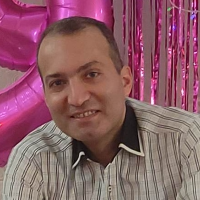A Comparative Study of the Wall Paintings of the Mausoleums Attributed to Agha Seyyed Muhammad Yemeni in "Kisom" and "Licha" in Gilan, Based on Recognition of Artist’s Personality
Author(s):
Article Type:
Research/Original Article (دارای رتبه معتبر)
Abstract:
In Gilan it has been common to paint the walls of mausoleums; though these painting had been irrelevant to the entombed person and even to the architecture and structure of these mausoleums. In other words, the architect and constructor of the mausoleum would not preordain or designate a specific place for painting, but the patron or the local people would hire a painter afterwards to paint the interior as well as the exterior walls of such mausoleums. In the east of Gilan province, there are two tombs with paintings attributed to Imamzade Seyyed Muhammad Yemeni; one in Licha village (Lasht Nesha city) and the other in Kisom (Astana Ashrafieh city). The wall paintings of these tombs include folk religious paintings. In Licha's tomb, the narrative frescoes are limited to the exterior, while the interior walls contain only calligraphy. However, both the interior and exterior walls of Kisom's tomb contain folk religious paintings. The paintings in the Licha tomb are signed "Mashhad Agha Jan Lahijani", while the painter in the Kisom tomb is not known. Some of the calligraphy is identical in both tombs; revealing the use of pre-made patterns (stereotypes) or repeatable patterns. The religious inscriptions of poetry and prayers complemented these paintings. The responsibility is given to the painter. Since most of the Gilan’s tomb painters did not have a good command of calligraphy and were not even literate, calligraphers prepared calligraphy designs for wall paintings and the painters bought them. Then, these designs were transferred on semi-transparent papers that were pasted together and made into stereotypes with needlework. Later, the stereotypes were placed on the walls and charcoal powder was used to draw lines on the plastered wall surface (which were prepared and smoothed). Finally, the artist draws the outer edges and paints the inside. Some stereotypes of these religious themes, painted by the artisans, were later made by their students and sold and bought in the same way as calligraphic designs. Some of the lines and motifs painted from the same narrative appear similar at first glance in both tombs, leading many researchers to argue that the murals in the Kisom tomb were painted by the same artist as the Licha tomb, namely, Mr. "Lahijani". The main goal of this research is to determine the identity of the painter of Kisom tomb. Due to the severe damage of the internal murals of Kisom mausoleum by the fire, a secondary goal of this study was to identify religious scenes using previous photographs and field surveys taken and recorded prior to the fire, and to reveal the precedence of the murals. The research questions are as follows: 1- Based on the comparative study, what kind of knowledge can be obtained from the identity of the painter of Kisom tomb? 2- The wall painting of which of these tombs was painted first? In this research, dealing with the similarities and differences between the wall paintings of these two tombs, as well as their unique features in a range of themes and visual elements is a touchstone to reach the answer to the research problem. For this purpose, the required data were collected through descriptive documents and field research and then evaluated using analytical and comparative methods. The findings of the research show that the painting style of the Kisom tomb murals is more similar to the painting style of Reza Lahijani than that of Agha Jan Lahijani. This supports the hypothesis that one of Reza Lahijani's students subsequently stereotyped, traced, and replicated the paintings of Baba Jan Dere's tomb to create the wall paintings of Kisom's tomb. As mentioned in the "Statement of the Problem" section, this type of tracing (use of a pre-made needle or hook motifs) has been common among tomb painters in Gilan province. Depending on the work conditions and the surface used for the mural painting, the painter sometimes modified these pre-made patterns. In addition, the artist sometimes mixes figures and visual elements from two different stereotypes. The wall paintings in the tomb of Kisom are examples of such works of art. However, the Licha tomb paintings display a more unified painting style. This study confirms the reports related to the destruction of the tomb of Kisom due to the flooding of the Sefid Rood River. As a result, this building and its wall paintings should be considered a more recent work.
Keywords:
Language:
Persian
Published:
Negareh journal, Volume:18 Issue: 66, 2023
Pages:
5 to 27
magiran.com/p2593082
دانلود و مطالعه متن این مقاله با یکی از روشهای زیر امکان پذیر است:
اشتراک شخصی
با عضویت و پرداخت آنلاین حق اشتراک یکساله به مبلغ 1,390,000ريال میتوانید 70 عنوان مطلب دانلود کنید!
اشتراک سازمانی
به کتابخانه دانشگاه یا محل کار خود پیشنهاد کنید تا اشتراک سازمانی این پایگاه را برای دسترسی نامحدود همه کاربران به متن مطالب تهیه نمایند!
توجه!
- حق عضویت دریافتی صرف حمایت از نشریات عضو و نگهداری، تکمیل و توسعه مگیران میشود.
- پرداخت حق اشتراک و دانلود مقالات اجازه بازنشر آن در سایر رسانههای چاپی و دیجیتال را به کاربر نمیدهد.
In order to view content subscription is required
Personal subscription
Subscribe magiran.com for 70 € euros via PayPal and download 70 articles during a year.
Organization subscription
Please contact us to subscribe your university or library for unlimited access!



